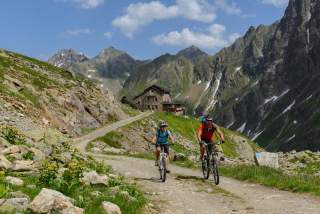1. Mountain biking makes you healthy and fit
Mountain biking is an endurance sports activity. Positive stress stimuli on your cardiovascular system as well as your muscles require a healthy body and realistic selfassessment. Avoid time pressure and slowly increase intensity and length of your tours.
2. Careful planning
Maps, guidebooks, the internet and experts give valuable information, helping you to choose a bike tour which suits your abilities. Adapt your tours to the ability of the group, pay attention to the weather forecast and to current conditions. Caution when you are alone: Already little incidents may lead to severe emergencies.
3. Only ride suitable roads and paths
Do not ride cross-country in order to prevent damage from erosion. Only use suitable roads and paths and respect local road closures and regulations in order to prevent conflicts with land owners, path supervisors and other users of natural resources.
4. Check your bike
Check brakes, air pressure, tight fit of the wheels, suspension and gears of your bike. An annual maintenance by a professional guarantees a technically perfect condition. See to a health-friendly sitting position.
5. Complete equipment
Pack warm clothing, rain and wind protection, a repair set as well as first aid kit into your backpack, just like mobile phone (Euro-emergency hotline 112), light and a sufficient amount of food and drinks. Gloves and glasses protect your hand and eyes. A map or GPS are valuable orientation guides.
6. Always wear a helmet
Uphill and downhill, always wear a helmet! In case of falling or a collision a helmet may prevent head injuries and even save your life. Protectors may prevent injuries.
7. Pedestrians have priority
Be considerate of pedestrians by announcing your approach and reducing your speed. If necessary, stop. Friendly greeting is a matter of courtesy and promotes acceptance. Drive in small groups of bikers and avoid paths highly frequented by hikers.
8. Control your speed
Adapt your speed to the respective situation. Drive carefully and ready to brake at all times as an obstacle may be just around the corner. In mountain biking courses you can practice your biking and braking skills.
9. Leave no trace
By controlled and smooth braking - so that your wheels will not block - you prevent ground erosion and damaging paths. Do not litter and make no excessive noise.
10. Be considerate of animals
For wild animals, twilight is the time for eating. Drive during daylight to avoid disturbing them. Approach animals at a walking speed and close pasture fences after drive-through.
